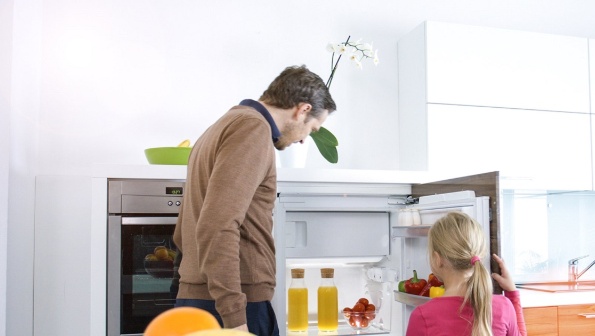
Today more than half of the world's population lives in cities; in 2050 two thirds of all people on earth will live in urbanized metropolitan areas. Traditional agriculture will not be able to provide such megacities with enough healthy nourishment. One possible solution: urban farming – growing tomatoes, melons and the like in the midst of the big city. But these plants will need to be fed as well, primarily with water and light. Compared to conventional light solutions in agriculture, LEDs achieve significant increases in energy efficiency and can thus help vegetable and fruit cultivation in the metropolises of the world finally break through.
Since space is becoming increasingly scarce, we have to start 'thinking vertically'.
Vertical Farming
More than just science fiction
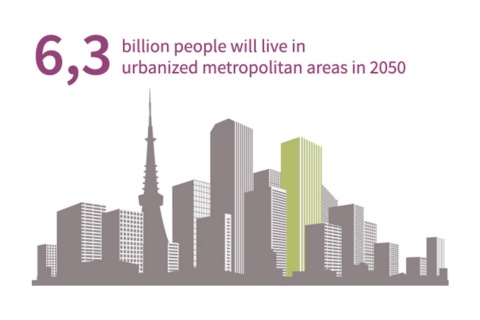
Arranged meticulously in long rows running down the large building, a sea of lettuce heads bathes in a pinkish light. What at first glance looks like a science fiction scenario already exists today in many metropolitan areas around the world: In so-called urban farms people in Asia, the USA and Europe are cultivating vegetables, herbs and fruits in the middle of the cityscape. In modern versions of the urban garden plot, agriculture has been relocated for example to old industrial buildings and warehouses.
LEDs (Light Emitting Diodes) can supply light e.g. with a larger red or blue component, exactly the light wavelengths plants such as iceberg lettuce, tomatoes and basil need for photosynthesis and for optimum growth. The light emitted by the diodes combines these color components and produces the pink aura. Another advantage: By using LED light the modern farmer is no longer dependent on natural light sources. Regardless of whether it's raining or the middle of the night, the constant light produced by the light emitting diodes ensures faster and more fertile plants development, whatever the weather is like.
Salad from a skyscraper
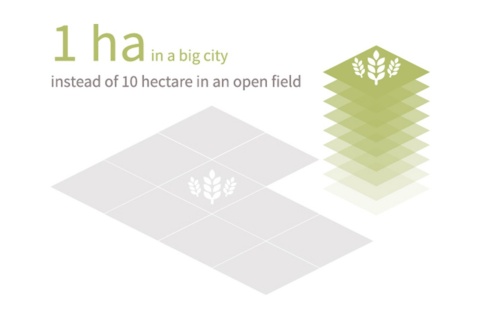
There's another dimension to producing sufficient food supplies in spite of limited arable land: Farming tasks are migrating not only to the city, they're also moving upwards. "Since space is becoming increasingly scarce, we have to start 'thinking vertically'," says Dr. Dickson Despommier of Columbia University, a visionary in the field of what's called Vertical Farming. In this form of urban agriculture, urban farmers cultivate fruits and vegetables in multi-storey buildings referred to as "farmscrapers". And these indoor farms often make due completely without sunlight, producing ample amounts of tomatoes, spinach and other crops on several stories under the best conditions all year round.
The concept is very promising: Vertical Farming can help provide nourishment to the growing populations found particularly in global megacities such as Mumbai in India or Shanghai in China. The yield of these vertical greenhouses is significantly higher than that of conventional agriculture. According to Despommier, a hectare of cultivated space in a farmscraper can replace an area ten times the size in an open field. Each year 500 m² can produce 50 tons of lettuce and vegetables, while at the same time making ideal use of the scarce urban space.
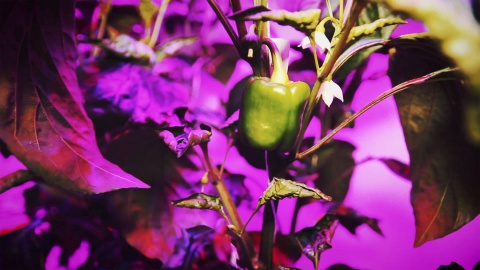
Modern light solutions
Japan among the forerunners
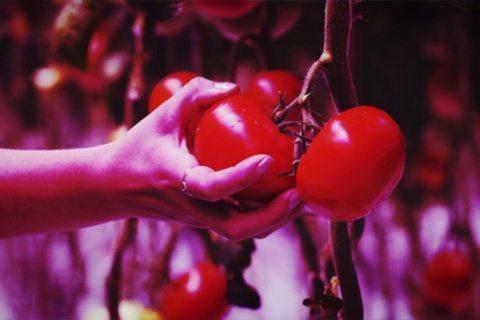
News of the advantages offered by these new urban farming concepts has already made its way around the world. As a result recent years have seen the creation of quite a few indoor farms in the megacities of the world. Among the forerunners we find Japan, a nation focusing its attention increasingly on sustainable energy solutions. And urban farms are another energy-efficient way to provide additional foodstuffs to growing metropolises: "Saving energy is of paramount importance in Japan. This is why modern light technologies such as the light emitting diodes have become highly successful there so quickly," says Ulrich vom Bauer from Lighting ICs Marketing at Infineon. "This applies in particular to what's called horticultural lighting, the illumination of greenhouses: Demand here has increased dramatically."
Innovative farming concepts protect the environment
Urban farming also helps conserve the environment by eliminating the long transport distances and the associated negative environmental impacts. In the USA 98 percent of lettuce is grown in California and Arizona. In order to bring the produce to consumers in New York City, a truck or freight train has to travel as much as 4,200 kilometers, consuming valuable energy all the way. And since transportation costs have a substantial influence on the sales price of vegetables, urban farming concepts could even make produce less expensive.
Up to now fruit and vegetables from vertical farms have only been available in a small number of select super markets. But as the large number of horticulture projects shows: Vegetable fields and fruit orchards are headed for the cities – and modern LED technologies from Infineon play a key role in lighting the way to farms in megacities from India to Mexico.

LED technologies
Save electricity with LED technologies from Infineon

Wondernica Research has also recognized the benefits of more energy-efficient light systems: The Malaysian company uses Infineon ICL8201 LED driver ICs in its newest LED tubes for greenhouses. The advantage: The light solution requires only a small number of external components and can be easily integrated in design concepts. They provide constant direct current to blue or red LEDs and to infrared LEDs to match the needs of the plant in question. This is another good example of how Infineon components for LED drivers save energy in greenhouse lighting while at the same time increasing the reliability of lighting systems.
Depending on the plant type, the ICL8201 LED driver ICs supply blue or red LEDs and infrared LEDs with constant direct current - an example of energy efficiency in the lighting of greenhouses.
Just the right spectrum of light
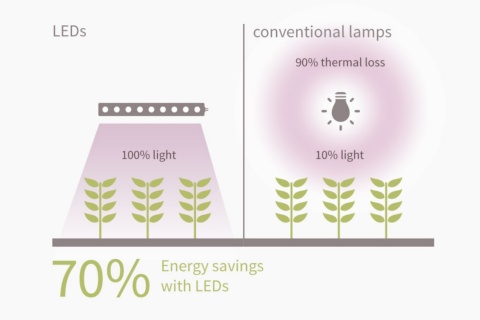
The decisive advantages of the LED go well beyond substantial energy savings: Plants need a variety of different wavelengths of light, depending on the type of plant and the growth phase. In order to produce fruit, tomato vines and the like primarily need blue light, which makes up a large portion of natural sunlight and promotes photosynthesis. Modern lighting systems based on LED technologies can be specifically set to the respective necessary wavelength and thus provide each individual plant type with just the right spectrum of light.
This modern technology also makes it easy to flexibly adjust illumination intensity in urban farms, meaning that plants no longer have to work to extend their stems towards the sun in order to reach the vitally essential sunlight. They can devote their entire energy to bearing fruit and thus achieve higher yields than the fellow members of their species in the field under the open sky. The various wavelengths of the light emitting diodes even make it possible to create specific colorings in the plants themselves, for example in the red lollo rosso lettuce leaves which are very popular in Northern Europe but very hard to find in autumn and winter. Thanks to LEDs, this kind of lettuce can be produced on location and no longer needs to be imported for example all the way from sunny Italy.
Optimally suited to urban farming

Compared to conventional light solutions used in plant farming, modern LED lighting systems are optimally suited to urban farming. They also score high in terms of energy efficiency: When urban farmers illuminate their plants using LEDs, the energy is consumed primarily by the plants themselves. Future energy savings of up to 70 percent would be possible if LEDs replaced the neon lamps now widely used in greenhouses. And light emitting diodes generate less heat than conventional lighting sources: Heat which rises and can overheat the growing space, making the LED ideal for use in cultivation areas arranged in vertical stories. LEDs also last much longer than conventional lights and provide just as much light.
In their vertical farms, big city farmers replace more than just sunlight with the reliable light of the LED; they also replace soil and rain. Hydroponic or aquaponic systems provide the urban greenhouse with a reliable supply of water and nutrients. Long hose networks carry a watery solution of minerals and other vitally essential elements directly to the roots of the basil, lettuce and zucchini plants.
Last update: November 2016


